 W
WThe Byzantine Empire was ruled by emperors of the dynasty of Heraclius between 610 and 711. The Heraclians presided over a period of cataclysmic events that were a watershed in the history of the Empire and the world in general.
 W
WThe Avar–Byzantine wars were a series of conflicts between the Byzantine Empire and the Avar Khaganate. The conflicts were initiated in 568, after the Avars arrived in Pannonia, and claimed all the former land of the Gepids and Lombards as their own. This led to them attempting to seize the city of Sirmium from Byzantium, which had previously retaken it from the Gepids, without success. Most of their future conflicts came as a result of raids by the Avars, or their subject Slavs, into the Balkan provinces of the Byzantine Empire.
 W
WThe Battle of Nikiou was a battle between Arab Muslim troops under General Amr ibn al-A'as and the Byzantine Empire in Egypt in May of 646.
 W
WThe Roman province of Egypt was established in 30 BC after Octavian defeated his rival Mark Antony, deposed Pharaoh Cleopatra, and annexed the Ptolemaic Kingdom to the Roman Empire. The province encompassed most of modern-day Egypt except for the Sinai Peninsula, which would later be conquered by Trajan. Aegyptus was bordered by the provinces of Crete and Cyrenaica to the west and Judea to the East.
 W
WThe Byzantine Empire had its first golden age under the Justinian Dynasty, which began in 518 AD with the Accession of Justin I. Under the Justinian Dynasty, particularly the reign of Justinian I, the Empire reached its largest territorial point, reincorporating North Africa, southern Illyria, southern Spain, and Italy into the Empire. The Justinian Dynasty ended in 602 with the deposition of Maurice and the ascension of his successor, Phocas.
 W
WThe Byzantine–Sasanian War of 602–628 was the final and most devastating of the series of wars fought between the Byzantine Empire and the Sasanian Empire of Iran. The previous war between the two powers had ended in 591 after Emperor Maurice helped the Sasanian king Khosrow II regain his throne. In 602 Maurice was murdered by his political rival Phocas. Khosrow proceeded to declare war, ostensibly to avenge the death of the deposed emperor Maurice. This became a decades-long conflict, the longest war in the series, and was fought throughout the Middle East: in Egypt, the Levant, Mesopotamia, the Caucasus, Anatolia, Armenia, the Aegean Sea and before the walls of Constantinople itself.
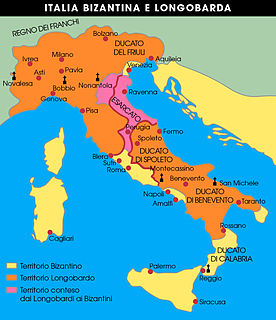 W
WThe Duchy of Perugia was a duchy in the Italian part of the Byzantine Empire. Its civil and military administration was overseen by a duke (dux) appointed by and under the authority originally of the Praetorian Prefect of Italy (554–584) and later of the Exarch of Ravenna (584–751). Its chief city and namesake was Perugia (Perusia), located at its centre. It was a band of territory connecting the Duchy of the Pentapolis to its northeast with the Duchy of Rome to its southwest, and separating the duchies of Tuscia and Spoleto, both parts of the Lombard Kingdom of Italy. It was of great strategic significance to the Byzantines since it provided communication between Rome, the city of the Popes, and Ravenna, the capital of the Exarchate. Since it cut off the Duke of Spoleto from his nominal overlord, the king ruling from Pavia, it also disturbed the Lombard kingdom, which was a constant thorn in the Byzantines' side. This strategic importance meant that many Lombard and Byzantine armies passed through it.
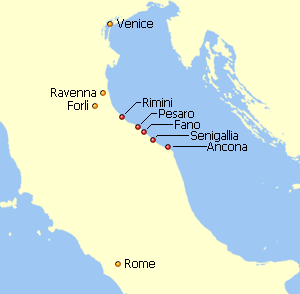 W
WIn the Byzantine Empire, the Duchy of the Pentapolis was a duchy, a territory ruled by a duke (dux) appointed by and under the authority of the Praetorian Prefect of Italy (554–584) and then the Exarch of Ravenna (584–751). The Pentapolis consisted of the cities of Ancona, Fano, Pesaro, Rimini and Sinigaglia. It lay along the Adriatic coast between the rivers Marecchia and Misco immediately south of the core territory of the exarchate ruled directly by the exarch, east of the Duchy of Perugia, another Byzantine territory, and north of the Duchy of Spoleto, which was part of the Lombard Kingdom of Italy. The duchy probably extended inland as far as the Apennine Mountains, perhaps beyond, and its southernmost town was Humana (Numera) on the northern bank of the Misco. The capital of the Pentapolis was Rimini and the duke was both the civil and military authority in the duchy.
 W
WThe praetorian prefecture of the East, or of the Orient was one of four large praetorian prefectures into which the Late Roman Empire was divided. As it comprised the larger part of the Eastern Roman Empire, and its seat was at Constantinople, the praetorian prefect was the second most powerful man in the East, after the Emperor, in essence serving as his first minister.
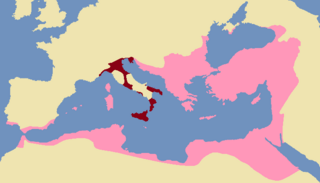 W
WThe Exarchate of Ravenna or of Italy was a lordship of the Eastern Roman Empire in Italy, from 584 to 751, when the last exarch was put to death by the Lombards. It was one of two exarchates established following the western reconquests under Emperor Justinian to more effectively administer the territories, along with the Exarchate of Africa.
 W
WThe Expedition of Tabuk, also known as the Expedition of Usra, was a military expedition that was initiated by Muhammad in October 630 AD. Muhammad led a force of as many as 30,000 north to Tabuk, near the Gulf of Aqaba, in present-day northwestern Saudi Arabia.
 W
WThe hexagram was a large silver coin of the Byzantine Empire issued primarily during the 7th century AD.
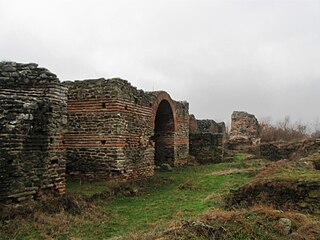 W
WJustiniana Prima was a Byzantine city that existed from 535 to 615, and currently an archaeological site, known as or Caričin Grad, near modern Lebane in southern Serbia. It was founded by Emperor Justinian I (527-565) and served as the metropolitan seat of the Archbishopric of Justiniana Prima, that had jurisdiction over the provinces of the Diocese of Dacia.
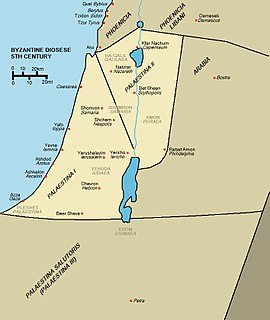 W
WPalæstina Prima or Palaestina I was a Byzantine province from 390, until the 7th century. It was lost to the Sassanid Empire in 614, but was re-annexed in 628, before its final loss during the Muslim conquest of the Levant in 636.
 W
WThe praetorian prefecture of Illyricum was one of four praetorian prefectures into which the Late Roman Empire was divided.
 W
WThe Slavic migrations to the Balkans are considered to have taken place mostly in the first decades of the 7th century in Late antiquity after a series of wars between the Sassanid Empire (Persia) and the Avar Khaganate against the Eastern Roman Empire. Also called the Byzantine Empire, it lost much of its territory in Egypt, the Levant, Asia Minor and the Balkans. These wars arose from conflicts both territorial and religious, with the Zoroastrians and Christians vying for power over Mesopotamia. The backbone of the Avar Khaganate consisted of Slavic tribes, which, after the failed siege of Constantinople in the summer of 626, remained in the wider Balkans after they had settled the Byzantine provinces south of the river Sava and Danube, from the Adriatic toward Aegean up to the Black Sea. Exhausted by wars and reduced to the coastal parts of the Balkans, Byzantium was not able to wage war on two fronts and to regain its lost territories, but it reconciled with the fact of establishing Slavic pagania and created an alliance with them against the Avar Khaganate in Pannonian Basin.
 W
WThe Thracesian Theme, more properly known as the Theme of the Thracesians, was a Byzantine theme in western Asia Minor. Created either in the mid-7th or the early 8th century as the settlement of the former Army of Thrace, after which it was named, it was one of the larger and more important themes of the Empire throughout its existence based on its proximity to Constantinople. The Thracesian Theme was one of the longest-lived themes, surviving until the region was conquered by the Turks in the early 14th century.